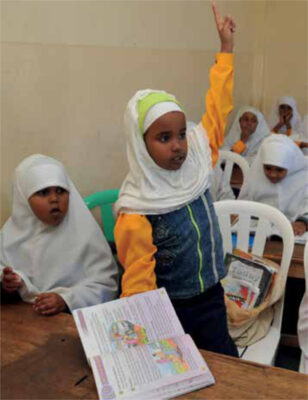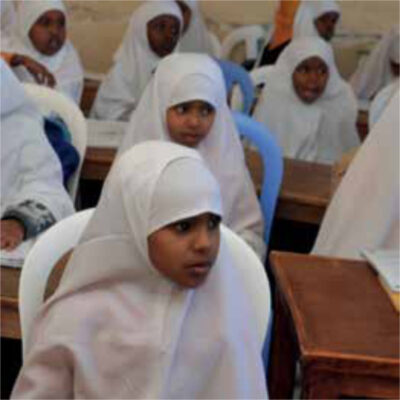Main content
Hiv treatment for children in sub-saharan Africa
Ending the AIDS epidemic among children, adolescents and young women by 2020: That is the ambition of the ‘Start free, stay free, AIDS-free’ program, launched by UNAIDS and PEPFAR in 2016. Much work still needs to be done to achieve this ambitious goal. Worldwide, an estimated 1.8 million children are living with HIV – the majority in sub-Saharan Africa. [1] Access to lifesaving antiretroviral treatment (ART) for these children has increased exponentially over the past twenty years, but with the increasing use of ART worldwide, the emergence of HIV drug resistance is an important threat to achieving an AIDS-free generation.
Various mechanisms make children living with HIV more vulnerable to developing HIV drug resistance. First, fewer antiretroviral drugs are approved for use in children, which makes it harder to switch to another drug in case of side effects or toxicity. Second, a growing child needs frequent dose adjustments to adapt the regimen to their changing pharmacokinetics and body weight, making accurate dosing difficult. Third, young children are dependent on their parents to receive their medication, who are often sick themselves or have even passed away. Older children might fear stigma when they disclose their HIV status to their peers, which limits their motivation to adhere to treatment. Finally, children who have been exposed to antiretroviral drugs perinatally, as a measure to prevent mother to child transmission (PMTCT) of HIV, have an increased risk of developing HIV drug resistance. In these children, HIV drug-resistant mutations may be present even before they start ART themselves, i.e. pretreatment drug resistance.

Pretreatment drug resistance
Relatively few data on pretreatment drug resistance in children are available. However, the studies conducted in sub-Saharan Africa (South-Africa, Swaziland, Cameroon, Tanzania, Central Africa Republic, Senegal, Uganda, Zimbabwe, Kenya, and Malawi) have shown an increasing prevalence over the past years. In a meta-analysis we found that 43% of children who were known to have been perinatally exposed to ART for PMTCT had pretreatment drug resistance. In children without PMTCT exposure, 13% had pretreatment drug resistance and this prevalence has increased significantly over the past years, from 0% in 2004 to 27% in 2013.[2] These figures imply that a growing number of children starting ART in sub-Saharan Africa have resistant viruses in their blood, against which the standard first-line treatment will not be effective. These children will not be able to achieve virological suppression with first-line therapy.
These worrying outcomes are reflected in the findings of a second meta-analysis we carried out. In this analysis, which included more than 51,000 children in sub-Saharan Africa and Asia, we found that after 12 months of first-line treatment only 65-73% of children had virological suppression, i.e. a viral load of less than 1000 virus copies/ml. [3] A comparable meta-analysis among adults in low- and middle-income countries found a much higher proportion of 85% achieving virological suppression. [4]
First-line treatment
In two cohort studies in Uganda and Nigeria, we enrolled around 500 HIV-infected children who were starting first-line ART and followed them for a period of two years. All children had a viral load test at treatment initiation and every six months thereafter. An HIV drug resistance test was done in children with a viral load of more than 1000 copies/ml. Both in Nigeria and Uganda we found that one in six children had pretreatment drug resistance. The majority of these children had not been perinatally exposed to ART. After two years of first-line treatment, 33% of the children experienced treatment failure of their first-line regimen, defined as either two consecutive viral load measurements >1000 copies/ml or death. The presence of pretreatment drug resistance was the most important predictor for treatment failure and increased the risk of failure by a factor of 7 to 15. [2,5]
At the start of this study in 2010, first-line treatment in both countries consisted of two nucleoside reverse transcriptase inhibitors (NRTI) and one non-nucleoside reverse transcriptase inhibitor (NNRTI). Children under the age of three who were known to have been exposed to ART for PMTCT were prescribed a first-line regimen consisting of two NRTIs and one protease inhibitor (PI). However, it is often not known if a child has been exposed to PMTCT, especially in older children or if the mother has passed away. Since 2013, the World Health Organization therefore recommends that all children under the age of three be treated with a regimen of two NRTIs and a PI. Unfortunately, PIs are more expensive than NNRTIs, and in many African hospitals these guidelines are therefore hard to implement in practice.
Second-line treatment
Second-line treatment usually consists of two NRTIs and a PI. PIs have a higher genetic barrier and therefore resistance is expected to develop less frequently. [6] In Uganda, we followed a group of 64 children starting second-line therapy. After two years, 20% of these children experienced treatment failure. Drug-resistant mutations against PIs were found in none of these children. [7] This implies that treatment failure was most likely due to poor treatment adherence and not to HIV drug resistance against second-line drugs. This finding is reassuring, especially given the fact that third-line medication is virtually unavailable in sub-Saharan Africa. However, if treatment adherence remains poor, drug-resistant mutations will eventually develop. Measures to improve treatment adherence are therefore needed. [7]
In a multicentre analysis of children in Africa and Asia, we found comparable results, with 16% of children failing treatment after two years of second-line treatment. Remarkably however, adolescents (aged 10-18 years) had an almost four times higher risk of failure compared to younger children [8] Poor treatment results for adolescents living with HIV have been found in other studies as well, and adolescents are increasingly recognized as an important risk group for HIV-related morbidity and mortality. In sub-Saharan Africa, HIV is the leading cause of mortality among adolescents, whereas this is no longer the case for younger children or adults. [9] Worldwide, the number of AIDS-related deaths decreased by 24% between 2004 and 2011, but AIDS-related mortality in adolescents increased by 50% over the same time period. [10] These poor treatment results call for an increased focus on adolescents living with HIV, not only to improve morbidity and mortality in the individual patient, but also to prevent transmission of HIV in adolescents when they become sexually active.

Conclusions
Enormous strides have been made in the fight against HIV since the beginning of the millennium. Access to life-saving treatment has increased, and nowadays more than half of the world’s population living with HIV is being treated with ART.[1] However, treatment outcomes for children on ART in sub-Saharan Africa still lag behind. The number of children achieving virological suppression on first-line ART is far below the so-called UNAIDS 90-90-90 target of 90% virological suppression to be achieved by 2020.[11]
The increasing prevalence of pretreatment drug resistance is a problem which will become increasingly important in the near future. Given the high rate of drug resistance against NNRTIs, it is important that WHO guidelines recommending PI-based first-line treatment are followed. For this to happen, drug prices need to go down, as the price of a PI is more than three times higher than of an NNRTI. Newer drugs such as integrase inhibitors could play an important role for children with HIV drug resistance, but these drugs are still almost not available in sub-Saharan Africa.
However, the development of potent antiretroviral drugs and improved access to these drugs in sub-Saharan Africa is not in itself enough to improve HIV care for children. Providing age-specific HIV care, including child-friendly formulations of drugs, and the implementation of adherence support programs are also needed. A combination of all these measures is needed to assure a healthy and productive future for children and adolescents living with HIV in sub-Saharan Africa and for achieving an AIDS-free generation.
Acknowledgement
This article is based on the PhD dissertation ‘Prevention, Suppression and Resistance: Antiretroviral Treatment for Children with HIV in Sub-Saharan Africa’. Promotors: prof dr T.F. Rinke de Wit & prof dr M. Boele van Hensbroek Co-promotors: dr J.C.J. Calis and dr.K.C.E. Sigaloff.
References
- World Health Organization (WHO). Summary of the Global HIV Epidemic. 2017. http://www.who.int/hiv/data/2017_summary-global-hiv-epidemic.png?ua=1.
- Boerma RS, Sigaloff KCE, Akanmu AS, et al. Alarming increase in pretreatment HIV drug resistance in children living in sub-Saharan Africa: a systematic review and meta-analysis. J Antimicrob Chemother 2017; 72: 365-71.
- Boerma RS, Boender TS, Bussink AP, et al. Subop-timal Viral Suppression Rates Among HIV-Infected Children in Low- and Middle-Income Countries: A Meta-analysis. Clin Infect Dis 2016; 63: 1645-54.
- Boender TS, Sigaloff KCE, Mcmahon JH, et al. Long-term Virological Outcomes of First-Line Antiretroviral Therapy for HIV-1 in Low- and Middle-Income Countries: A Systematic Review and Meta-analysis. Clin Infect Dis 2015; 61: 1453-61.
- Kityo C, Boerma RS, Sigaloff KCE, et al. Pre-treatment HIV drug resistance results in virological failure and accumulation of addi-tional resistance mutations in Ugandan children. J Antimicrob Chemother 2017; 72: 2587-95.
- Van den Vijver D, Wensing A, Angarano G, et al. The Calculated Genetic Barrier for Antiret-roviral Drug Resistance Substitutions Is Largely Similar for Different HIV-1 Subtypes. J Acquir Immune Defic Syndr 2006; 41: 352-60.
- Boerma RS, Kityo C, Boender TS, et al. Second-line HIV Treatment in Ugandan Children: Fa-vorable Outcomes and No Protease Inhibitor Resistance. J Trop Pediatr 2017; 63: 135-43.
- Boerma RS, Bunupuradah T, Dow D, et al. Multicentre analysis of second-line antiretroviral treatment in HIV-infected children: Adolescents at high risk of failure. J Int AIDS Soc 2017; 20. DOI:10.7448/IAS.20.1.21930.
- Kyu HH, Pinho C, Wagner JA, et al. Global and National Burden of Diseases and Injuries Among Children and Adolescents Between 1990 and 2013. JAMA Pediatr 2016; 170: 267-87.
- Kasedde S, Luo C, McClure C, Chandan U. Reducing HIV and AIDS in adolescents: Opportunities and challenges. Curr HIV/AIDS Rep 2013; 10: 159-68.
- UNAIDS. 90-90-90: On the right track towards the global target. 2016. http://www.cfenet.ubc.ca/sites/default/files/uploads/IAS2016/90_90_90_Prog-ress_ReportFINAL.pdf (accessed Sept 6, 2016).


















































